Request for Assistance in...
Preventing Silicosis and Deaths in Construction Workers
NIOSH ALERT: 1996
DHHS (NIOSH) Publication No. 96-112
| |
Request for Assistance in...Preventing Silicosis and Deaths in Construction WorkersNIOSH ALERT: 1996
|
WARNING!Exposure to respirable crystalline silica dust during construction activities can cause serious or fatal respiratory disease. |
The National Institute for Occupational Safety and Health (NIOSH) requests assistance in preventing silicosis and deaths in construction workers exposed to respirable crystalline silica. Construction workers, coworkers, managers, and equipment manufacturers urgently need information about the hazards of breathing respirable crystalline silica. Your assistance in this effort will help prevent silicosis-related death and disease, a national goal for health promotion and disease prevention stated in Healthy People 2000 [PHS 1990].
This Alert describes six case reports of construction workers who have died or are suffering from silicosis. In addition, the Alert cites examples of five construction operations that used poor dust controls and two operations that used good dust controls.
NIOSH requests that editors of trade journals, safety and health officials, labor unions, owners, and employers bring the recommendations in this Alert to the attention of all workers who are at risk.
Types of Silica
Crystalline silica may be of several distinct types. Quartz, a form of silica and the most common mineral in the earth's crust, is associated with many types of rock. Other types of silica include cristobalite and tridymite.
Potential for Exposure During Construction
Concrete and masonry products contain silica sand and rock containing silica. Since these products are primary materials for construction, construction workers may be easily exposed to respirable crystalline silica during activities such as the following:
Even materials containing small amounts of crystalline silica may be hazardous if they are used in ways that produce high dust concentrations.
Description of Silicosis
When workers inhale crystalline silica, the lung tissue reacts by developing fibrotic nodules and scarring around the trapped silica particles [Silicosis and Silicate Disease Committee 1988]. This fibrotic condition of the lung is called silicosis. If the nodules grow too large, breathing becomes difficult and death may result. Silicosis victims are also at high risk of developing active tuberculosis [Myers et al. 1973; Sherson and Lander 1990; Bailey et al. 1974].
A worker's lungs may react more severely to silica sand that has been freshly fractured (sawed, hammered, or treated in a way that produces airborne dust) [Vallyathan et al. 1988]. This factor may contribute to the development of acute and accelerated forms of silicosis.
Types of Silicosis
A worker may develop any of three types of silicosis, depending on the airborne concentration of crystalline silica:
Chronic silicosis, which usually occurs after 10 or more years of exposure to crystalline silica at relatively low concentrations
Accelerated silicosis, which results from exposure to high concentrations of crystalline silica and develops 5 to 10 years after the initial exposure
Acute silicosis, which occurs where exposure concentrations are the highest and can cause symptoms to develop within a few weeks to 4 or 5 years after the initial exposure [Peters 1986; Ziskind et al. 1976]
Complications
Initially, workers with silicosis may have no symptoms. As silicosis progresses, there may be difficulty in breathing and other chest symptoms such as cough. Infectious complications may cause fever, weight loss, and night sweats. Severe mycobacterial or fungal infections can complicate silicosis and may be fatal [Ziskind et al. 1976; Owens et al. 1988; Bailey et al. 1974]. Fungal or mycobacterial infections are believed to result when the lung cells (macrophages) that fight these infections are overwhelmed with silica dust and are unable to kill mycobacteria and other organisms [Allison and Hart 1968; Ng and Chan 1991]. About half of the mycobacterial infections are caused by Mycobacterium tuberculosis (TB), with the other half caused by M. kansasii and M. avium-intracellulare [Owens et al. 1988]. Nocardia and Cryptococcus may also cause infections in silicosis victims [Ziskind et al. 1976].
Medical evaluations of silicosis victims usually show the lungs to be filled with silica crystals and a protein material [Owens et al. 1988; Buechner and Ansari 1969]. Pulmonary fibrosis (fibrous tissue in the lung) may or may not develop in acute cases of silicosis, depending on the time between exposure and onset of symptoms.
Furthermore, evidence indicates that crystalline silica is a potential occupational carcinogen [NIOSH 1988; IARC 1987; DHHS 1991], and NIOSH is reviewing the data on carcinogenicity.
Occupational Safety and Health Administration (OSHA)
The current OSHA permissible exposure limit (PEL) for respirable dust containing crystalline silica (quartz) for the construction industry is measured by millions of particles per cubic foot (mppcf) and is calculated using the following formula [29 CFR* 1926.55]:
250 mppcf
PEL† = ___________
% silica +5_________________________________________________ *Code of Federal Regulations. See CFR in references.†8-hour time-weighted average (TWA).
The current OSHA PEL for respirable dust containing crystalline silica (quartz) for general
industry is as follows [29 CFR 1910.1000]:
10 mg/m3 or 250 mppcf
PEL = ___________ ___________
% silica +2 % silica +5NIOSH
The NIOSH recommended exposure limit (REL) for respirable crystalline silica is 0.05 mg/m3 (50 µg/m3) as a TWA for up to 10 hours/day during a 40-hour workweek [NIOSH 1974].
Silicosis Cases
Case No. 1--Sandblaster
A 39-year-old man was diagnosed with silicosis (progressive massive fibrosis) and tuberculosis in April 1993 after working 22 years as a sandblaster. He had noticed a gradual increase in shortness of breath, wheezing, and discomfort from minimal exertion. Tissue taken from his lungs showed extensive fibrosis.
The sandblaster was first diagnosed with silicosis in 1991 when a coworker had developed tuberculosis and the State health department had administered chest X-rays and skin testing to the entire crew. He was one of 20 workers who sandblasted welds during water tank construction to prepare the metal for painting. While sandblasting, he wore a charcoal filter respirator. During a 10- to 11-hour day, he spent 6 hours sandblasting.
Two brothers and three nephews who worked with him all tested positive for tuberculosis. A brother-in-law had also worked at the company for 20 years but had died from progressive silicosis in 1984 at age 42.
Case No. 2--Tile Installer
A white male nonsmoker was diagnosed with advanced silicosis, emphysema, and asthma at age 49 after working 23 years as a tile installer. He had reported shortness of breath and pneumonia.
His work included polishing and drilling tile, and he was exposed to grout dust and sandblasting (though he did not do sandblasting). He did not use a respirator. Information about dust controls was not available.
Case No. 3--Brick Mason
A white male nonsmoker was diagnosed with silicosis, emphysema, and lung cancer at age 70 after working 41 years as a mason laying brick. The diagnosis was made after an open lung biopsy (a chest X-ray had shown no evidence of silicosis).
This worker spent part of his time around coke ovens doing fire brick work. He wore a respirator when he was working in dusty conditions. Information about dust controls was not available.
Case No. 4--Rock Driller
A 47-year-old man was diagnosed with severe silicosis after working 22 years as a rock driller. He was diagnosed in 1992 after he was brought to a hospital with respiratory failure and right heart failure. In the Spring of 1994, while he was on a ventilator, he died from respiratory failure. His autopsy confirmed advanced silicosis.
Before this worker's diagnosis, he had never seen a doctor and had never had a chest X-ray. The drills he used were equipped with dust controls, but they were routinely inoperable.
Case No. 5--Tunnel Worker
A white male worker died of silicosis at age 69 after working 2 years as a tunnel construction worker and 40 years as a nurse. He had been a smoker until age 59 and was exposed to silica during his 2-year employment in tunnel construction. Information about respirator use and dust controls was not available.
His nursing assignments included 5 years with the U.S. Public Health Service, 27 years with an automobile manufacturer, 1 year with a paper manufacturer, 6 years with various hospitals, and 1 year with a magazine publisher.
Case No. 6--Building Renovation Mason
A 55-year-old man was diagnosed in 1994 with simple silicosis after working 30 years as a building renovation mason. Although a lung biopsy revealed silicotic nodules, he was still working as of 1995.
This mason used an air-supplied respirator while sandblasting during the past 25 years. Sand (or occasionally coal slag) was the usual abrasive. The frequency of sandblasting was reported to be 12 times per year in the past and twice per year currently. Periodically, the mason used a handheld masonry saw with no water on the blade (though he did wear a disposable particulate filter respirator).
Exposures at Sites with Poor Dust Controls
Exposures to respirable crystalline silica at the following construction sites exceeded the NIOSH REL of 0.05 mg/m3 for up to 10 hours/day during a 40-hour workweek [NIOSH 1974].
New Building Construction, April 1992
At the site of a new building under construction (Figure 1), a sandblaster was employed to blast the surface of a poured concrete structure using silica sand. The sandblaster wore a supplied-air, Type CE continuous-flow respirator, but his helper used no respiratory protection. The amount of air flow through the supplied-air respirator was not determined. Other workers nearby (some only 20 to 25 feet from the sandblasting at various times) were either using disposable particulate respirators or had access to them. For the sandblaster, 60-minute personal air samples indicated a respirable quartz concentration of 0.68 mg/m3 inside and 1.83 mg/m3 outside the Type CE continuous-flow respirator. For the blaster helper, a 57-minute personal air sample indicated a respirable quartz concentration of 0.52 mg/m3. A 65-minute area air sample indicated a respirable quartz concentration of 0.26 mg/m3.
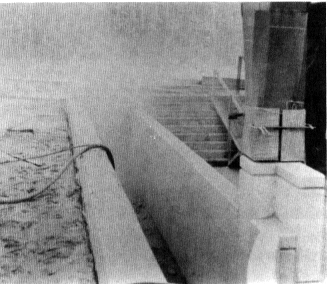 |
Figure 1. Abrasive blasting of concrete containing crystalline silica (silica sand is the abrasive). |
At the demolition site of a small bridge, handheld drills and a concrete saw were used to weaken the structure. The commercial-type saw consisted of a steel diamond-tipped blade in a large portable circular-saw housing. The saw used water to prevent wear of the blade. Respiratory protection was not used by any of the workers present. For a worker using a handheld drill, a 45-minute personal air sample indicated a respirable quartz concentration of 0.78 mg/m3. For a concrete saw operator, a 45-minute personal air sample indicated a respirable quartz concentration of 1.64 mg/m3. Area air samples indicated concentrations of 0.0, 0.65, 1.96, and 2.15 mg/m3 respirable quartz.
Multistory Building Renovation, August 1992
During renovation of a high-rise office building (Figure 2), a plumber cut the concrete floor on each of the 16 floors to install rest room floor drains. He wore a disposable particulate respirator and used a floor-stand fan to direct dust out the window. A 350-minute personal air sample indicated a respirable quartz concentration of 14.2 mg/m3. Area air samples indicated 3.2, 3.36, and 4.1 mg/m3 respirable quartz. Other workers in the area (such as elevator mechanics) were exposed without respiratory protection.
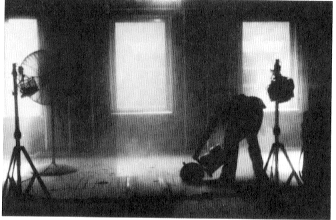 |
Figure 2. Plumber sawing concrete floors containing crystalline silica. |
At the site of a building under construction (Figure 3), a hillside was drilled and blasted to give access to the building site. A drill operator stood at the controls of a drill without a cab; he wore a half-face respirator with pesticide cartridges, which he had purchased himself at an auto parts store. During air sampling, the dust collection system for the drill was not operable, and water was not used as a dust suppressant. A 324-minute personal air sample indicated a respirable quartz concentration of 0.80 mg/m3.
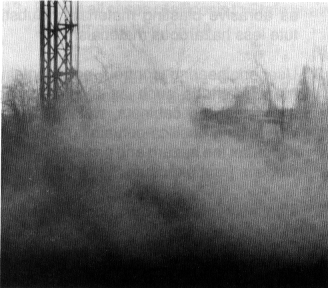 |
Figure 3. Drilling of rock containing crystalline silica during building site preparation. |
During interstate highway repair, four workers drilled horizontal holes in concrete pavement after a rectangular portion of damaged concrete was removed (Figure 4). Two of the workers operated backhoes fitted with a special drill attachment, and the other two workers positioned the drill and drilled the holes. No dust collection system or water suppressant was in use. One of the backhoe operators wore a disposable particulate respirator, and the other wore a half facepiece particulate cartridge respirator. One drill operator wore a disposable particulate respirator, and the other wore a quarter-facepiece particulate filter respirator. Personal air samples (approximately 200 minutes each) were taken on two different days. Air concentrations were above the REL for one of the backhoe operators on the first day (0.08 mg/m3) and for both drill operators on both days (0.81 and 0.41 mg/m3 on day 1, and 0.42 and 0.32 mg/m3 on day 2).
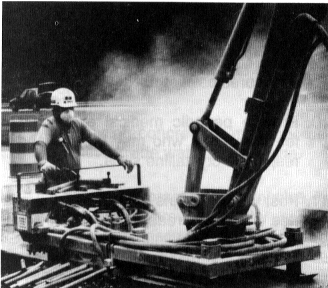 |
Figure 4. Drilling of concrete pavement containing crystalline silica during interstate highway repair. |
Exposures to respirable crystalline silica at the following construction sites were below the NIOSH REL of 0.05 mg/m3 for up to 10 hours/day during a 40-hour workweek [NIOSH 1974]. These examples illustrate that exposures to silica can be controlled in the construction industry through the use of engineering controls‡ and work practices.§
______________________________
‡Engineering controls are hazard controls designed into equipment and workplaces.
§Work practices are procedures followed by employers and workers to control hazards.
Highway Construction with Hillside Drilling and Blasting
At a highway construction site, a hillside was drilled and blasted to make room for a new, wider highway (Figure 5). The drill operator was seated in an enclosed, air-conditioned drill cab. Two shifts were sampled without detecting respirable quartz in air samples from the driller's cab or from a personal sampler on the driller--even though bulk dust samples of the drill cuttings indicated 60%, 71%, 55%, and 60% quartz.
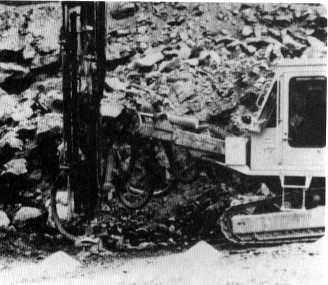 |
Figure 5. Drilling of rock containing crystalline silica during highway construction. |
At a new highway construction site, the concrete pavement was sawed to provide expansion joints for the concrete (Figure 6). Two workers operated commercial-type pavement saws, and one operated a water truck. The water truck provided water for the blades of the two saws (gravity feed). Personal air samples were collected for the three workers during a 4-hour shift and a 9-hour shift. Respirable quartz was not detected in any of the samples even though bulk dust samples indicated that the concrete samples contained 18%, 19%, 21%, 22%, and 24% quartz.
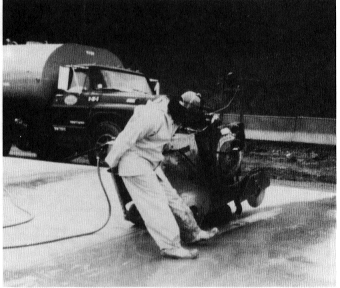 |
Figure 6. Sawing of concrete pavement containing crystalline silica during highway construction. |
This Alert illustrates the variety of conditions in the U.S. construction industry that can lead to the development of silicosis. Efforts to prevent silicosis may be inadequate if any of the five following conditions exist:
NIOSH recommends the following measures to reduce exposures to respirable crystalline silica in the workplace and to prevent silicosis and deaths in construction workers:
These recommendations are discussed briefly in the following subsections.
Dust Control
The key to preventing silicosis is to keep dust out of the air. Dust controls can be as simple as a water hose to wet the dust before it becomes airborne. Use the following methods to control respirable crystalline silica:
Personal Hygiene
The following personal hygiene practices are essential for protecting workers from respirable crystalline silica and other contaminants such as lead, particularly during abrasive-blasting operations [NIOSH 1991a]:
Protective Clothing
Take the following steps to assure that dusty clothes do not contaminate cars, homes, or worksites outside the dusty area:
Air Monitoring
Air monitoring is needed to measure worker exposures to respirable crystalline silica and to select appropriate engineering controls and respiratory protection. Perform air monitoring as needed to measure the effectiveness of controls. Collect and analyze air samples according to NIOSH Method Nos. 7500 and 7602 [NIOSH 1994] or their equivalent.
Use of Respirators
Do not use respirators as the primary means of preventing or minimizing exposures to airborne contaminants. Instead, use effective source controls such as substitution, automation, enclosed systems, local exhaust ventilation, wet methods, and good work practices. Such measures should be the primary means of protecting workers. However, when source controls cannot keep exposures below the NIOSH REL, controls should be supplemented with the use of respirators.
Respiratory Protection Program
When respirators are used, the employer must establish a comprehensive respiratory protection program, as outlined in the NIOSH Guide to Industrial Respiratory Protection [NIOSH 1987a] and as required in the OSHA respiratory protection standard [29 CFR 1910.134 and 1926.103]. Important elements of this standard are
--periodic environmental monitoring,The respiratory protection program should be evaluated regularly by the employer.
--regular training of personnel,
--selection of proper NIOSH-approved respirators,
--an evaluation of the worker's ability to perform the work while wearing a respirator,
--respirator fit testing, and
--maintenance, inspection, cleaning, and storage of respiratory protection equipment.
Type CE Abrasive-Blasting Respirators
Type CE abrasive-blasting respirators are the only respirators suitable for use in abrasive-blasting operations. Currently, four Type CE abrasive-blasting respirators are certified by NIOSH [NIOSH 1996]:
1. A continuous-flow respirator with a loose-fitting hood and an assigned protection factor (APF) of 25
2. A continuous-flow respirator with a tight-fitting facepiece and an APF of 50
3. A positive-pressure respirator with a tight-fitting, half-mask facepiece and an APF of 1,000
4. A pressure-demand or positive-pressure respirator with a tight-fitting full facepiece and an APF of 2,000
NIOSH recommends that workers wear a Type CE, pressure-demand or positive-pressure, abrasive-blasting respirator (APF of 1,000 or 2,000) during abrasive-blasting operations that involve crystalline silica.
Other Respirators
For operations other than abrasive blasting, Table 1 lists the minimum respiratory equipment required to meet the NIOSH REL for crystalline silica under given conditions. Use the most protective respirator that is feasible and consistent with the tasks to be performed. For additional information about respirator selection, consult the NIOSH Respirator Decision Logic [NIOSH 1987b]. Workers should use only respirators that have been certified by NIOSH and MSHA [NIOSH 1991b] according to 30 CFR 11, or respirators certified by NIOSH according to 42 CFR 84 (effective July 10, 1995).
| Condition | Minimum respiratory protection required to meet the NIOSH REL (0.05 mg/m3) |
| < 0.5 mg/m3* (10 x REL) | Any half-mask, air-purifying respirator with a high-efficiency particulate filter† |
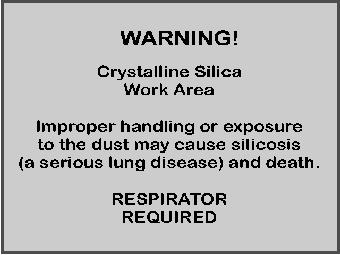 |
Figure 7. Sample warning sign for silica work area requiring respirators. |
Workers should receive safety training and education that includes the following [29 CFR 1926.21]:
Surveillance and Disease Reporting
NIOSH encourages reporting of all cases of silicosis to the State health departments and OSHA. To encourage uniform reporting, NIOSH has developed reporting guidelines and a surveillance case definition for silicosis (see Appendix). This definition and these guidelines are recommended for surveillance of work-related silicosis by State health departments and regulatory agencies receiving reports of cases from physicians and other health care providers [CDC 1990].
The principal contributors to this Alert were Kenneth D. Linch; Dennis W. Groce; Karl J. Musgrave; Ruth A. Jajosky; Steven R. Short; and John E. Parker. Please direct comments, questions, or requests for additional information to Dr. Gregory Wagner, Director, Division of Respiratory Disease Studies, NIOSH, 1095 Willowdale Road, Morgantown, West Virginia 26505-2888; Telephone: (304) 285-5749.
NIOSH would also like to thank the Silicosis SENSOR Program States for their work in preventing silicosis:
Illinois [Celan Alo and Roy Maxfield, (217) 785-1873]
Michigan [Ken Rosenman and Mary Jo Reilly, (517) 353-4979]
New Jersey [Martha Stanbury, (609) 984-1863]
North Carolina [Bill Jones and Susan Randolph, (919) 715-3625]
Ohio [Ed Socie and Nan Migliozzi, (614) 466-4183]
Texas [Teresa Willis and Dennis Perrotta, (512) 458-7269]
Wisconsin [George Gruetzmacher and Henry Anderson, (608) 266-1253]
We greatly appreciate your assistance in protecting the lives of U.S. workers.
Linda Rosenstock, M.D., M.P.H.
Director
National Institute for Occupational
Safety and Health
Centers for Disease Control
and Prevention
Allison AC, Hart PD [1968]. Potentiation by silica of the growth of Mycobacterium tuberculosis in macrophage cultures. Br J Exp Pathol 49:465-476.
ATS/CDC (American Thoracic Society and Centers for Disease Control) [1986]. Treatment of tuberculosis and tuberculosis infection in adults and children. Am Rev Respir Dis 134(2):355-363.
Bailey WC, Brown M, Buechner HA, Weill H, Ichinose H, Ziskind M [1974]. Silico-mycobacterial disease in sandblasters. Am Rev Respir Dis 110:115-125.
Buechner HA, Ansari A [1969]. Acute silico-proteinosis. Dis Chest 55(4):274-284.
CDC (Centers for Disease Control) [1990]. Silicosis: cluster in sandblasters--Texas, and occupational surveillance for silicosis. MMWR 39(25):433-437.
CFR. Code of Federal regulations. Washington, DC: U.S. Government Printing Office, Office of the Federal Register.
DHHS [1991]. Sixth annual report on carcinogens: 1991. Vol. 2. Research Triangle Park, NC: U.S. Department of Health and Human Services, Public Health Service, National Toxicology Program, National Institute of Environmental Health Sciences, pp. 731-738.
IARC [1987]. IARC monographs on the evaluation of the carcinogenic risk of chemicals to humans: silica and some silicates. Vol. 42. Lyon, France: World Health Organization, International Agency for Research on Cancer, pp. 49, 51, 73-111.
ILO (International Labour Office) [1981]. Classification of radiographs of the pneumoconioses. Med Radiogr Photogr 57(1):2-17.
Myers CE, Hayden C, Morgan J [1973]. Clinical experience with silicotuberculosis. Penn Med (March): 60-62.
Ng TP, Chan SL [1991]. Factors associated with massive fibrosis in silicosis. Thorax 46(4):229-232.
NIOSH [1974]. Criteria for a recommended standard: occupational exposure to crystalline silica. Cincinnati, OH: U.S. Department of Health, Education, and Welfare, Public Health Service, Center for Disease Control, National Institute for Occupational Safety and Health, HEW Publication No. (NIOSH) 75-120, pp.54-55, 60-61.
NIOSH [1987a]. Guide to industrial respiratory protection. Cincinnati, OH: U.S. Department of Health and Human Services, Public Health Service, Centers for Disease Control, National Institute for Occupational Safety and Health, DHHS (NIOSH) Publication No. 87-116.
NIOSH [1987b]. Respirator decision logic. Cincinnati, OH: U.S. Department of Health and Human Services, Public Health Service, Centers for Disease Control, National Institute for Occupational Safety and Health, DHHS (NIOSH) Publication No. 87-108.
NIOSH [1988]. NIOSH testimony to the U.S. Department of Labor: statement of the National Institute for Occupational Safety and Health. Presented at the public hearing on OSHA proposed rule on air contaminants: silica, crystalline-cristobalite (respirable), August 1, 1988. NIOSH policy statements. Cincinnati, OH: U.S. Department of Health and Human Services, Public Health Service, Centers for Disease Control, National Institute for Occupational Safety and Health.
NIOSH [1991a]. NIOSH Alert: request for assistance in preventing lead poisoning in construction workers. Cincinnati, OH: U.S. Department of Health and Human Services, Public Health Service, Centers for Disease Control, National Institute for Occupational Safety and Health, DHHS (NIOSH) Publication No. 91-116.
NIOSH [1991b]. NIOSH certified equipment list as of December 31, 1990. Cincinnati, OH: U.S. Department of Health and Human Services, Public Health Service, Centers for Disease Control, National Institute for Occupational Safety and Health, DHHS (NIOSH) Publication No. 91-105.
NIOSH [1994]. Silica, crystalline, by XRD: Method 7500 (supplement issued 8/15/94); silica, crystalline by IR: Method 7602 (supplement issued 8/15/94). In: Eller PM, ed. NIOSH manual of analytical methods. 4th ed. Cincinnati, OH: U.S. Department of Health and Human Services, Public Health Service, Centers for Disease Control and Prevention, National Institute for Occupational Safety and Health, DHHS (NIOSH) Publication No. 94-113.
NIOSH [1996]. NIOSH respirator user notice: type CE abrasive-blast supplied-air respirators. Morgantown, WV: Department of Health and Human Services, Public Health Service, Centers for Disease Control and Prevention, National Institute for Occupational Safety and Health, Division of Safety Research.
Owens MW, Kinasewitz GT, Gonzalez E [1988]. Case report: sandblaster's lung with mycobacterial infection. Am J Med Sci 295(6):554-557.
Peters JM [1986]. Silicosis. In: Merchant JA, Boehlecke BA, Taylor G, Pickett-Harner M, eds. Occupational respiratory diseases. Cincinnati, OH: U.S. Department of Health and Human Services, Public Health Service, Centers for Disease Control, National Institute for Occupational Safety and Health, DHHS (NIOSH) Publication No. 86-102, pp. 219-237.
PHS [1990]. Healthy people 2000: national health promotion and disease prevention objectives. U.S. Department of Health and Human Services, Public Health Service. Washington, DC: U.S. Government Printing Office S/N 017-001-00474-0.
Sherson D, Lander F [1990]. Morbidity of pulmonary tuberculosis among silicotic and nonsilicotic foundry workers in Denmark. J Occup Med 32(2):110-113.
Silicosis and Silicate Disease Committee [1988]. Diseases associated with exposure to silica and nonfibrous silicate minerals. Arch Pathol Lab Med 112:673-720.
Vallyathan V, Shi X, Dalal NS, Irr W, Castranova V [1988]. Generation of free radicals from freshly fractured silica dust: potential role in acute silica-induced lung injury. Am Rev Respir Dis 138:1213-1219.
Ziskind M, Jones RN, Weill H [1976]. Silicosis. Am Rev Respir Dis 113:643-665.
State health departments should encourage physicians, including radiologists and pathologists, as well as other health-care providers, to report all diagnosed or suspected cases of silicosis. These reports should include persons with:
A. A physician's provisional or working diagnosis of silicosis,
OR
B. A chest radiograph interpreted as consistent with silicosis,
OR
C. Pathologic findings consistent with silicosis.
State health departments should collect appropriate clinical, epidemiologic, and workplace information on persons reported with silicosis as needed to set priorities for workplace investigations.
Surveillance Case Definition
A.1. History of occupational exposure to airborne silica dust,
AND
2. Chest radiograph or other imaging technique interpreted as consistent with silicosis,†
OR
B. Pathologic findings characteristic of silicosis.‡
† Cases can be classified as simple or complicated. Simple silicosis is present if the largest opacity is <1 cm in diameter. Complicated silicosis (also known as progressive massive fibrosis [PMF]) is present if the largest opacity is 1 cm in diameter. Common radiographic findings of nodular silicosis include multiple, bilateral, and rounded opacities in the upper lung zones; other patterns have been described. Since patients may have had mixed dust exposure, irregular opacities may be present or even predominant. Radiographs interpreted by NIOSH-certified "B" readers should have profusion categories of 1/0 or greater by the International Labour Organization classification system [ILO Committee on Pneumoconiosis 1981]. A bilateral alveolar filling pattern is characteristic of acute silicosis and may be followed by rapid development of bilateral small or large opacities.
‡ Characteristic lung tissue pathology [Silicosis and Silicate Disease Committee 1988] in nodular silicosis consists of fibrotic nodules with concentric "onion-skinned" arrangement of collagen fibers, central hyalinization, and a cellular peripheral zone, with lightly birefringent particles seen under polarized light. In acute silicosis, microscopic pathology shows a periodic acid-Schiff positive alveolar exudate (alveolar lipoproteinosis) and a cellular infiltrate of the alveolar walls.
Reprinted from CDC [1990], p. 436.
WARNING!Exposure to respirable crystalline silica dust during construction activities can cause serious or fatal respiratory disease. |
Take the following steps to protect yourself from exposure to crystalline silica:
|
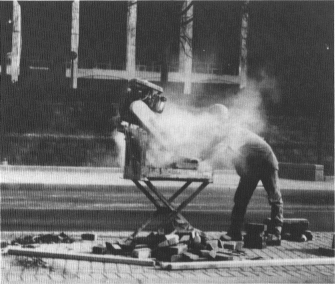
Construction worker sawing masonry without dust control or a respirator. |
Preventing Silicosis and Deaths in Construction Workers--DHHS (NIOSH) Publication No. 96-112
Go back to the NIOSH home page ![]() or to the CDC home page.
or to the CDC home page. ![]()